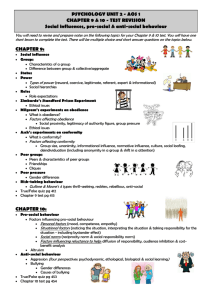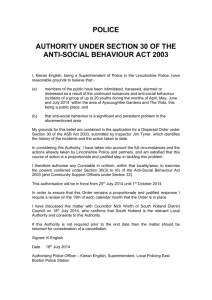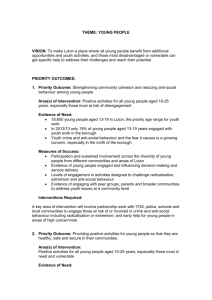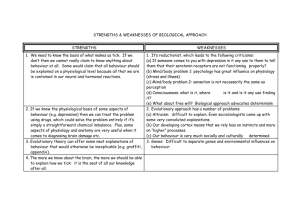a2.pro-social behavi..
advertisement
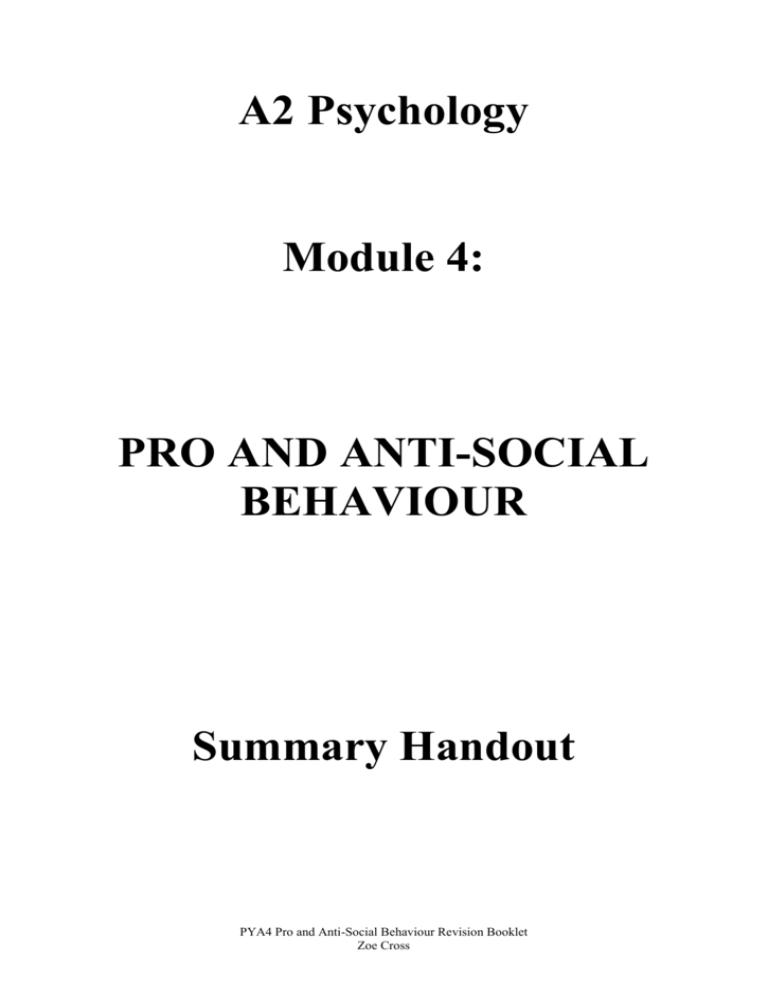
A2 Psychology Module 4: PRO AND ANTI-SOCIAL BEHAVIOUR Summary Handout PYA4 Pro and Anti-Social Behaviour Revision Booklet Zoe Cross MODULE 4 - PRO-AND ANTI-SOCIAL BEHAVIOUR Ref Content PASB 1 Nature and Causes of Aggression Notes? Understand ? Revised ? Social psychological theories of aggression (e.g. social learning theory, deindividuation, relative deprivation) including research studies relating to these theories. Research into the effects of environmental stressors on aggressive behaviour. PASB 2 Altruism and Bystander behaviour Explanations (e.g. empathy - altruism, negative state relief) and research studies relating to human altruism and bystander behaviour. Cultural differences in pro-social behaviour. PASB 3 Media Influences on Pro-and Anti-Social Behaviour Explanations and research studies relating to media influences on pro-and anti-social behaviour. SAMPLE QUESTIONS 1) Describe and evaluate one social psychological theory of aggression (24) 2) Critically consider research into effects of two environmental stressors on aggressive behaviour (24) 3) a) Outline two or more explanations for human altruism. b) Evaluate these and / or other explanations with reference to research studies. 4) a) Outline research evidence relating to bystander behaviour (12) b) Assess the effects of cultural differences on pro-social behaviour (12) 5) Critically consider two research studies relating to media influences on anti-social behaviour (24) 6) "There is much public interest in the debate about the effects of violence in the media on the behaviour of young children: but why don't people focus more on the potentially pro-social influences ?" Discuss the above quotation in relation to the pro-and anti-social effects of the media (24) PYA4 Pro and Anti-Social Behaviour Revision Booklet Zoe Cross PASB1 -SOCIAL PSYCHOLOGICAL THEORIES OF AGGRESSION THEORY ONE - SOCIAL LEARNING THEORY "MIRROR VID" MODELLING IMITATION REINFORCEMENT RESPONSE ACQUISITION OBSERVATIONAL LEARNING RECALL VICARIOUS LEARNING IMITATION DETERMINED BY ENVIRONMENT EVALUATION OF SOCIAL LEARNING THEORY EVIDENCE BANDURA - "BOBO DOLL STUDIES" PROCEDURE - Child watched another behaving aggressively towards toy clown CONDITIONS - several variations e.g. gender, age , consequences, on film etc. FINDINGS - CHILD SUBSEQUENTLY BEHAVED MORE VIOLENTLY TOWARDS CLOWN -especially if ; Child was same gender as model Model was 'rewarded' for aggression (see next page for more details) PYA4 Pro and Anti-Social Behaviour Revision Booklet Zoe Cross MORE DETAIL: (if a studies question comes up) The experiments carried out by Bandura et al. involved children observing aggressive and non-aggressive adult models and then being tested for imitative learning in the absence of the model. The participants were male and female children ranging from 3 to 5 years. Half the experimental children were exposed to aggressive models interacting with a life-sized inflatable Bobo doll and half were exposed to models that were nonaggressive in their behaviour towards the doll. The model displayed some distinctive physically aggressive acts, such as striking the doll on the head with the mallet and kicking it about the room, accompanied by verbal aggression such as saying ‘POW’. After exposure to the model, children were frustrated by being shown attractive toys that they could not play with, and were then taken to a room where, among other toys, there was a Bobo doll. Children in the aggression condition reproduced a good deal of physical and verbal aggressive behaviour resembling that of the model. Children in the nonaggressive and control groups (who had no prior experience of the Bobo doll) exhibited virtually no aggression toward the Bobo doll. Approximately one-third of the children in the aggressive condition also repeated the model’s non-aggressive verbal responses while none of the children in either the nonaggressive or control groups made such remarks. Boys reproduced more imitative physical aggression than girls but the groups did not differ in their imitation of verbal aggression. PYA4 Pro and Anti-Social Behaviour Revision Booklet Zoe Cross Second Social Psychological Theory of Aggression- DEINDIVIDUATION An emotional state One feels or perceives oneself to be anonymous Not being observed Leads to lessening of moral restraint Reduction of monitoring of one's own behaviour Lack of self awareness More responsive to environmental cues Evidence Mann - well documented cases of crowds urging possible suicides to jump. (this is aggression - intention to harm) especially when; At night Crowd was large Crowd was some distance away A02 1) Information from newspapers - is this valid ? 2) Both jumper and crowd are 'faceless' A rather more artificial study is Zimbardo's prison study. Zimbardo's famous study in which students took on the role of prisoner and guard in simulated prison situation. Several factors worked to deindividuate participants; 1) dress 2) head 'shaved' (stocking) 3) Uniforms 4) Mirrored sunglasses Zimbardo also did some 'Milgram - style' execution studies. People gave higher shocks if they were referred to by a number and wearing a hood. This is 'cos they felt anonymous, therefore deindividuated. AO2 Does the research allow for individual differences ? - Race, culture, age, class, interpersonal reactivity (Davis) Explanatory power ? - doesn't explain domestic violence or peaceful crowds (why?) But - crowds make us more responsive to external cues. If crowd is happy, so are we. If crowd is violent, so are we. Does explain institutional violence e.g. prison, army, schools. Also explains military atrocities such as Mai Lai massacre (explain why! - they were in a crowd in uniform) PYA4 Pro and Anti-Social Behaviour Revision Booklet Zoe Cross MORE DETAIL ON ZIMBARDO (if studies question comes up) ZIMBARDO CONTROLLED OBSERVATION 24 college students (white / male) To examine conformity to SOCIAL ROLES and expectations -Subjects psychologically tested for mental stability -Randomly allocated prisoner or guard role -Prisoners undergo realistic / humiliating arrest procedure -Prison regime established (e.g. uniforms issued ) Perverted relationship developed between guards and prisoners Study abandoned after 5 days 5 prisoners released early with psychotic / psychosomatic symptoms. Situation makes "good men do evil deeds". Loss of restraint due to DEINDIVIDUATION CONFORMITY to SOCIAL ROLES Lack of E.V. Experimenter effect Shows conformity to wider society, not just those present in the room. PYA4 Pro and Anti-Social Behaviour Revision Booklet Zoe Cross ENVIRONMENTAL STRESSORS CROWDING AND TEMPERATURE CROWDING DEINDIVIDUATION Reduces individuality Person is ‘depersonalised'Lessening of moral restraint STOKOLS '76 - Three conceptualisations of link between crowding and aggression; Stimulus overload Behavioural constraint Ecological model see next page for moreA02 for crowding Evidence Calhoun 'rat universe' - increase in pop. density led to aggression. But can’t be extrapolated Heavily congested traffic routes lead to higher aggression (Green) A lovely thing to do here would be to explain road rage in terms of all four approaches Day Nursery – aggression increased in day nursery as got more crowded.(Loo) Prison- Riots increase as prison pop. density does (McCain et al) (Do you really need these last two ? depends how much material you can cover !) TEMPERATURE High temp leads to aggression in the lab Baron & Bell – as heat went up , subjects were more likely to give electric shocks to others, unless it got too hot. Then they were less likely. There was a curvilinear relationship: HEAT AGGRESSION PYA4 Pro and Anti-Social Behaviour Revision Booklet Zoe Cross possible lack of ecological validity ?- Has been supported by some naturalistic studies. Correlations – Riots correlate with high temperatures in weather reports (Baron & Ransenberger) So do assault rape and murder (Anderson), but there’s no ‘tailing off ‘, like there is in the lab. FINAL A02 POINT both crowds and temperature lead to PHYSIOLOGICAL AROUSAL But it might depend upon your cognitive interpretation of the arousal. (Crowds can be uplifting, fun, inspiring etc) PYA4 Pro and Anti-Social Behaviour Revision Booklet Zoe Cross ALTRUISM & BYSTANDER BEHAVIOUR (They're different but connected !) CASE STUDY -THE MURDER OF KITTY GENOVESE Two psychologists, Latane & Darley , investigated this case and used it as a basis for their DECISION MODEL LATANE & DARLEY’s -DECISION MODEL DECISION = Not “Do I help or not ?” But “Is my help required ?” 5 KEY FACTORS influence the decision; SITUATION AMBIGUITY PLURALISTIC IGNORANCE SITUATION LACKS DEFINITION DIFFUSION OF RESPONSIBILITY AUDIENCE INHIBITION So, crowds discourage altruism (helping behaviour), because if it’s not clear what needs to be done, we’d rather let someone else do it than make a fool of ourselves. IMPLICATIONS: Bystander Apathy is caused by THE SITUATION The larger the number of bystanders, the less likely you are to get help. Implications for modern city life. HOW TO GET HELP BEAMAN – Teach people Psychology (more helped after viewing film) CIALDINI – ‘De-victimise’ yourself. RESEARCH SUPPORT FOR LATANE & DARLEY BASIC PARADIGM – staged deceptions involving confederates. Independent variable – usually number of ‘bystanders’ Dependent variable – length of time subject takes to respond to incident. SMOKE-FILLED ROOM SEIZURE INCIDENT WOMAN IN DISTRESS ? PYA4 Pro and Anti-Social Behaviour Revision Booklet Zoe Cross EMPATHY ALTRUISM HYPOTHESIS (2nd theory of Altruism) We empathise with people in distress, which motivates us to help relieve the person's distress The reason we help could be egostic or altruistic depending on how we feel. An egoist helps to make himself feel better(lessen his own distress / arousal) and an altruist helps to make other people feel better. A02 BATSON’S RESEARCH SUPPORT Do we offer to take other people’s shocks out of empathy or in order to lessen personal distress ? This is a long and complicated study; Basically – there’s someone receiving electric shocks. The subject can leave or take their place. If they leave they will reduce their own arousal . But IF EMPATHY IS PROMOTED they stay and take their place – so empathy is more important than arousal. They promote empathy by pointing out how similar the subject is to the person receiving the shocks . This should be easy to lay into for A02 ! More details (if research study question comes up) Helping Elaine (Batson et al., 1981) The empathy-altruism model predicts that people high in empathic concern are more likely to help another person even when they are in a position to escape from this responsibility, whereas those low in empathetic concern will choose escape if the ‘cost’ of escaping is low (see diagram on right). In one study, Batson et al. (1981) used a placebo drug which had no real effects but would led participants to interpret their reactions as high or low empathy. Participants then watched a female confederate (‘Elaine’) apparently receiving random electric shocks. After two trials the confederate appeared to become distressed. Participants were then faced with a difficult decision – take her place (showing empathetic concern) or leave (showing only personal distress). Batson et al. found that those in the high empathy condition tended to stay even when given the opportunity to leave, whereas those in the low empathy condition, when offered the chance to leave, took it. However if the cost of leaving was high (they had to do an onerous task if they left) then those in the low empathy condition were more likely to stay – even more likely than those in the high empathy condition. PYA4 Pro and Anti-Social Behaviour Revision Booklet Zoe Cross CULTURAL DIFFERENCES IN PROSOCIAL BEHAVIOUR . 1) Kitty Genovese 38 people watched – no-one rang police. -seen as reflection of modern life Does it reflect city life ? Or is such behaviour (‘bystander apathy) a universal ? There is some evidence that helping behaviours may depend upon cultural context 2) The Findings 100% 3-10 yr old Kenyan Kids altruistic (8% North American) LAB STUDIES –People don’t like to ask for help (especially North Americans) FIELD STUDIES – People happy to ask for help (especially Asians) So – contradictory findings – depends on research method (link to A02) In lab could be demand effect, need to appear confident, fear of evaluation etc. Other factors – depends who asks for help Foreigners get help in Greece Locals get help in Paris and Boston. 3) The Theory INDIVIDUALIST VS. COLLECTIVIST CULTURES INDIVIDUALIST Developed world Industrial Nuclear family Self Interest Isolated individual COLLECTIVIST Developing world Pre-industrial Extended family Community interest Integrated individual 4) Modern Society makes us more anti-social (a modern malaise) Kitty Genovese perhaps wouldn’t have died if in village in Kenya EISENBURG & MUTTEN – Meta-study – middle class American kids less helpful than any other culture USE STANDARD A02 POINTS BLAG IT – Social Learning Theory – different cultures provide different role models. PYA4 Pro and Anti-Social Behaviour Revision Booklet Zoe Cross Explanations and research studies relating to media influences on pro-and anti-social behaviour. MEDIA AND ANTI-SOCIAL FOUR KEY PROCESSES DESENSITISATION - violence doesn't shock us TV needs to get more violent to ‘thrill’ us (Gadow) Kids who watch violent Tv show later less likely to report a fight (Drabman & Thomas) IMITATION - we copy violence (This is the clearest / strongest argument of the four) Use the MIRROR VID and Bobo Doll stuff – link it to TV ! AROUSAL - viewing violence arouses us However, link with violent TV and arousal not that strong in most studies ! DISINHIBITION - We become more likely to use violence Seen as a ‘proper’ way to resolve conflicts. DIFFERENT TYPES OF RESEARCH EXPT - BANDURA Use the Bobo Doll studies here. A02 – lack of EV FIELD EXPT. – Park et al. used U.S. and Belgian boys in young offenders institutions – Boys who watched 5 violent films were more violent. A02 – representative sample? Hard to quantify aggression LONGITUDINAL STUDY- Eron & Huesman If boys watched a lot of violent TV at 8, then more likely to be violent at 18 and in prison at 30. A02 – Too many variables to control properly, attrition. LONGITUDINAL STUDY- Milavsky 3 year study of over 3000 children and teenagers – asked friends how violent they were, asked children themselves to state what TV there was – looked for relationship between the two A02 – both measured variables very problematic here ? Other A02 Other theories – Freud (catharsis) , evolutionary theory Individual differences Eron & Huesmann found only 10% aggression down to TV Hard to quantify aggression. PYA4 Pro and Anti-Social Behaviour Revision Booklet Zoe Cross More detail on anti-social media studies: Meta-analysis of research (Paik and Comstock, 1994) A substantial number of laboratory and field experiments over the past half-century have examined whether children exposed to violent behaviour on film or television behave more aggressively immediately afterwards. A meta-analysis of media violence research was conducted by Paik and Comstock (1994). They examined 217 studies of the relationship between media violence and aggressive behaviour. The studies were carried out between 1957 and 1990, with an age range from 3 to 70 years of age. They found a highly significant relationship between television violence and aggressive behaviour. The greatest effect was evident in pre-school children, and the effect for males was slightly higher than it was for females. A natural experiment - the St. Helena study (Charlton et al., 2000) A recent study was in St. Helena, a British Colony in the South Atlantic Ocean, which received television for the first time in 1995. Despite expectations that the introduction of television would produce an increase in anti-social behaviour, the researchers concluded that very little changed following television’s arrival. The vast majority of the measures used to assess pro- and anti-social behaviour showed no differences in either after the introduction of television. Those measures that did show a difference were fairly equally split between positive and negative changes. Five of these showed decreases in pro-social behaviour in boys and girls, but two showed increases (boys only). There were only two significant changes in anti-social behaviour scores – both of which were lower after the introduction of television. PYA4 Pro and Anti-Social Behaviour Revision Booklet Zoe Cross MEDIA / T.V. and PROSOCIAL BEHAVIOUR KEY EXPLANATIONS SOCIAL LEARNING THEORY - TV REINFORCES PRO-SOCIAL BEHAVIOUR LEARN THAT 'MIRROR VID' REALLY WELL!! EVIDENCE Mildarsky '73 - if child observes altruistic behaviour and the model is rewarded, then the child is likely to repeat the helping behaviour Stein & Friedrich '72 - kids watch TV for 4 weeks, (aggressive, neutral or pro-social). Pro-social condition showed more helpfulness, co-operation and affection Baron '79 - kids who watched episode of The Waltons with strong pro-social theme were later more helpful than those who hadn't. Sprafkin & Rubenstein - kids who prefer to watch pro-social TV are more sociable in school. EMPATHY / AROUSAL THEORIES Negative state relief model Empathy-altruism theory Empathic Joy Model EVIDENCE Strategies deployed by TV charity appeals.- e.g. unflinching exposure to suffering of others. MESSENGER-DAVIES - FUNCTIONAL Model of TV TV has many positive functions; -Common interests -shared understanding -Ideas for play and creativity EVIDENCE Children's Television Workshop set up in '68 - produced Sesame Street - promotes social values. Forge & Phemister - kids who don't watch programmes such as Sesame St. are less likely to be altruistic in schools. GUNTER & McALEER - TV is EDUCATIONAL Informative programming can introduce children to wide variety of people places and ideas. PYA4 Pro and Anti-Social Behaviour Revision Booklet Zoe Cross A02 SESAME STREET VIEWED DAILY IN OVER 70 COUNTRIES, SO HOW COME THE WORLD ISN'T A NICER PLACE ? There are two limitations to pro-social TV; DURATION OF EFFECT Hearold '86- META-STUDY of 100 studies in this field. - pro-social TV does have an effect (probably greater than anti-social) - but no-one knows how long it lasts. Sagotsky et al '81- Pro-social models produced more persistent behaviour changes in 8 yr olds, compared to 6 yr. olds. SITUATION-SPECIFICITY Lovelace & Huston '83 - learning from such situations can often be situation-specific (this is why domestic dramas work best) More detail (if pro-social STUDIES come up) Exposure to pro-social behaviour Are children exposed to pro-social programming? A recent survey found that US programmes for preschool children did have high levels of pro-social content; 77% of programmes surveyed contained at least one pro-social lesson. However, the survey also found that only 4 of the top 20 most watched TV programmes for under 17s contained pro-social lessons (Woodard, 1999). Acquisition of pro-social behaviours and norms Some studies of pro-social effects (such as the study by Poulos et al.) looked at oneshot exposures to a pro-social model. In general, the findings are that children are most affected when they are shown the exact steps for positive behaviour, such as being shown someone donating tokens (Mares and Woodard, 2001). This may be because they can remember concrete acts better than abstract ones. Learning pro-social norms (rather than specific behaviours) from the media may be less common, except possibly when viewing is accompanied by follow-up discussion. For example, in the study by Johnston and Ettema (on left) the largest effects were found when the program was viewed in the classroom and accompanied by teacherled discussions. However, there are cases where this doesn’t work. Rubenstein and Sprafkin (1982), in a study of adolescents hospitalised for psychiatric problems, found that post-viewing discussion led to decreased altruism. This possibly happened because the adolescents wanted to take up a view that was counter to the view held by the adults. PYA4 Pro and Anti-Social Behaviour Revision Booklet Zoe Cross
